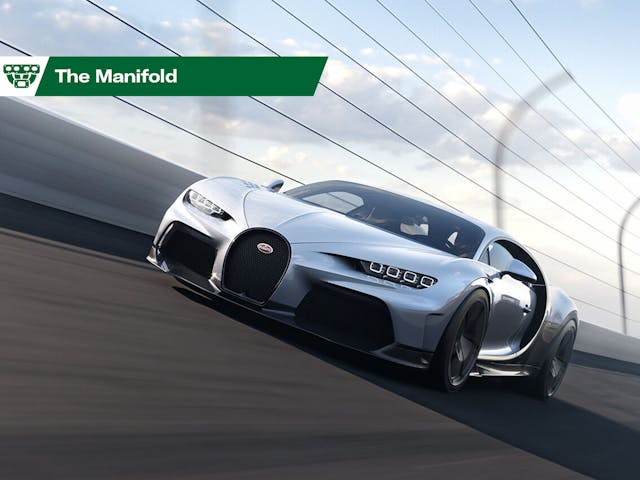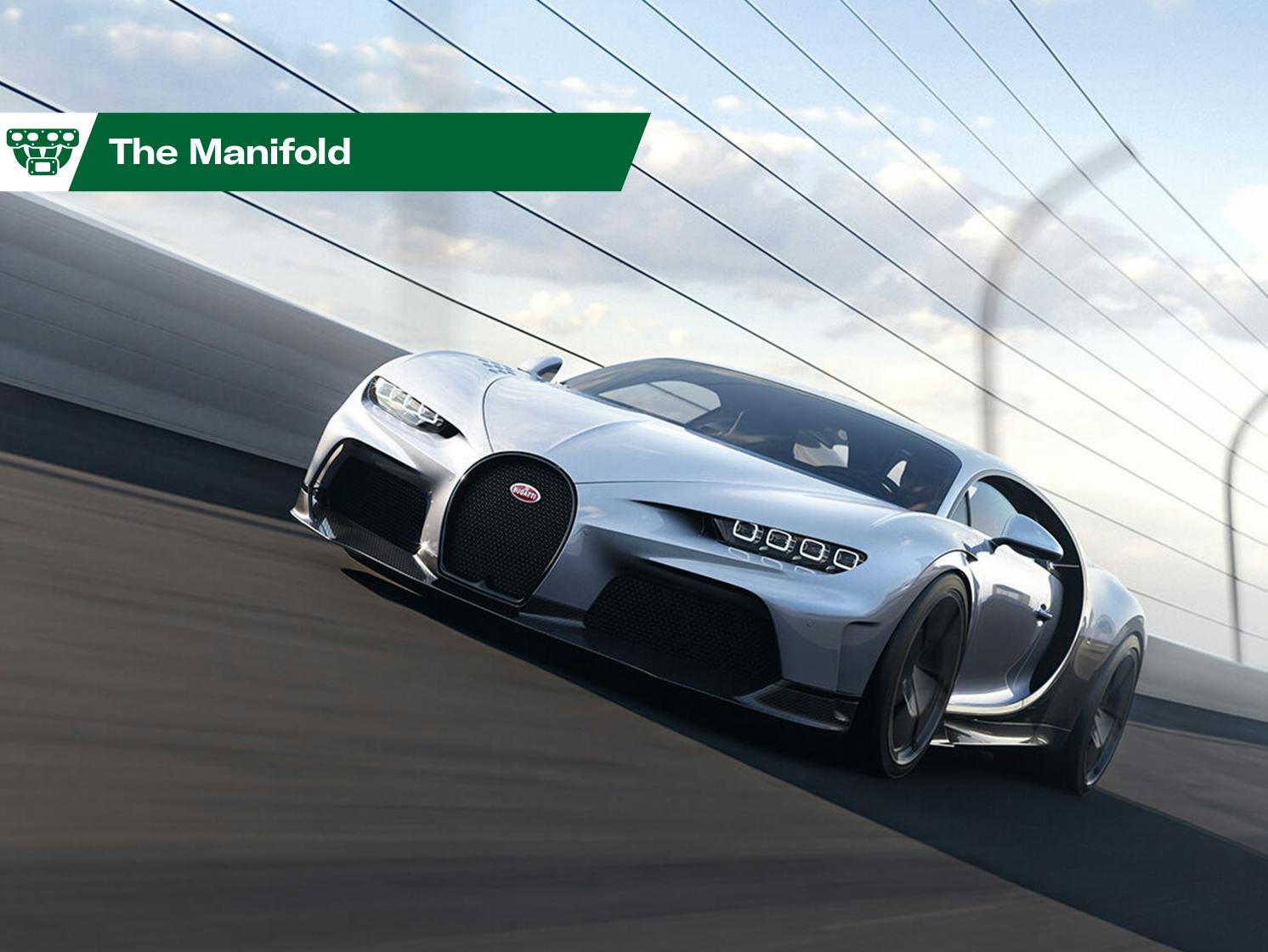Media | Articles
Bugatti limits latest Chiron to 273 mph, BMW’s X3 M and X4 M twins hit the gym, Swales fashions a V-12 E-Type homage
$3.9M Bugatti Chiron Super Sport is limited to 273 mph
Intake: Bugatti is building just nine examples of its new Chiron Super Sport, which the company says is the “ultimate grand tourer.” The car is based on the long-tail Chiron Super Sport 300+ that test driver Andy Wallace maxed out at 304.8 mph in 2019. This latest version, however, is restricted to a paltry 273 mph. On the plus side, the car is 50 pounds lighter than a standard Chiron and 9.8 inches longer to aid its aero performance. The eight-liter, quad-turbo, W-16 engine puts out 1577 hp and 1180 lb-ft of torque and is coupled to a new quad exhaust arrangement. Zero to 124 mph takes just 5.8 seconds and the Chiron Super Sport will reach 186 mph in 12.1. There are tweaks to the gearing, steering, and suspension, and it rides on unique Y-spoke wheels shod with Michelin Pilot Sport Cup 2 tires rated to 311 mph.
Exhaust: Bugatti’s business model is built on the seemingly continuous turnover of ever more expensive and faster limited editions, but we can’t help think that the buyers of this $3.9 million car may feel a little short-changed compared to those of 2020’s Chiron Super Sport 300+.
BMW’s X3 M and X4 M twins hit the weight room and the plastic surgeon
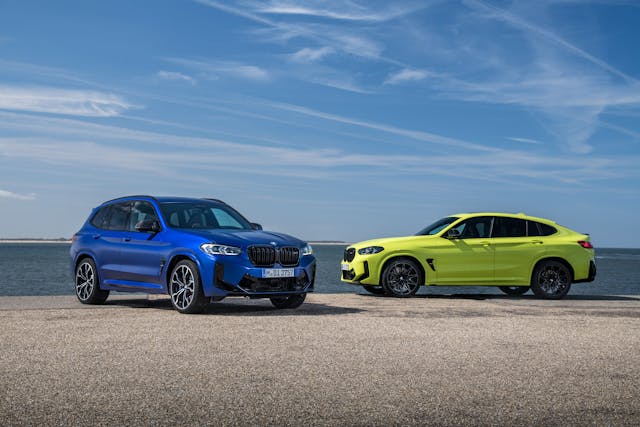
Intake: BMW’s smallest performance crossover siblings, the X3 M and X4 M, are getting some extra torque and a few styling tweaks for the 2022 model year. On the standard variants of both, the updated S58 twin-turbo inline-six engine now produces 457 lb-ft of torque, up 13 lb-ft from the previous model year. The gnarlier Competition versions now produce 479 lb-ft of torque, 37 more than before. Horsepower figures on both remain the same: 473 and 503, respectively. Advances in torque come by way of a new lightweight forged crankshaft and a 3D-printed cylinder head core. Both rides put the added grunt to good use, dropping 0–60 times from 4.1 seconds to 3.9 on the standard models, and from 4.0 to 3.7 on the Competition models. A host of styling tweaks include an enlarged kidney grille, updated M-specific front bumpers, and tweaked lighting elements.
Exhaust: As incongruous as they seem on paper, high-performance crossovers are only becoming more popular. These updates should keep the Bimmer twins on par with their competitors like the Mercedes-AMG GLC63 and the Porsche Macan Turbo, especially as all three grow a tad long in the tooth. The Macan is our choice for the best driving of the three, but the X3 M in particular is a commendable alternative.
E-Type homage gets a glorious handbuilt V-12
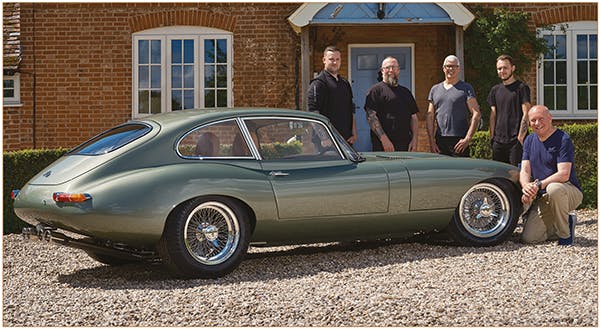
Intake: British Jaguar specialist Neville Swales is reimagining the Jaguar E-Type with a mighty 6.1- or 6.8-liter V-12 engine. At his Coventry-based Building the Legend facility the British engineer is to build 24 cars over the next six years in coupe, roadster, or low-drag versions, with coachwork by local experts. At the heart of each car will be Swales’ quad-cam “tera” V-12 engine which has been designed to be powerful, sculptural, and future-proof, as the rather wonderful mass of chrome can be powered by carbon-neutral e-fuels. Swales developed the “tera” for a run of cars based on Jaguar’s 1966 XJ13 prototype and has now managed to squeeze it under the hood of an E-Type. Each car will be built to the buyer’s specification and the first four are already sold, with prices from £415,000 ($588,000).
Marketplace
Buy and sell classics with confidence
Exhaust: Jaguar only fitted a 5.3-liter V-12 to its Series III E-Type, so Swales’ cars are unique. If you think of them as rivals for an Eagle GT rather than as alternatives to an original Jaguar (at about a third of the price), this intriguing offering starts to make sense.
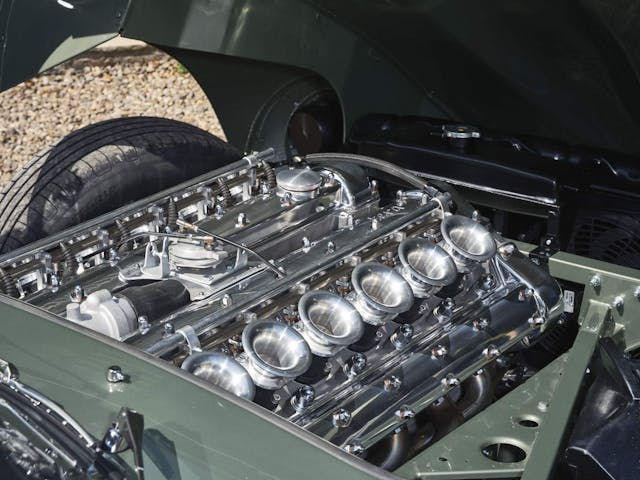
Jaguar’s 2022 I-Pace EV is $12K cheaper and comes in only one trim

Intake: Consistent with the rest of Jaguar’s 2022 model year changes, designed to simplify the ordering process, the I-Pace will only be available in one spec, the previously range-topping HSE. Comparing the 2020 HSE to the 2022 version—Jaguar skipped the 2021 model year for this EV—reveals a nearly $12K price drop, though the final price of $71,050 (destination included) nearly matches that of 2020’s base model ($71K). That said, those able to resist the pull of a tried-and-true ICE Jaguar get more for their money than in previous years: Pivi Pro infotainment, heated and cooled leather chairs, LED lights front and rear, and a 825-watt, 16-speaker Meridian sound system. Power output and range remain the same: 394 hp and 512 lb-ft of torque from a two-motor setup, and 234 miles of range from a 90-kWh battery pack.
Exhaust: Jaguar North America’s CEO Joe Eberhardt admits that this slinky EV “was maybe ahead of its time.” As we know, that isn’t always a good thing. Introduced for 2018, the lovely I-Pace lost ground early to cheaper, more predictable JLR products, and its ho-hum range is no longer competitive against that of today’s Teslas and Polestars. This update won’t catapult it into the spotlight, but the select few with their hearts set on an I-Pace will find the 2022 model a better value.
Lordstown Motors discloses dire financial concerns for its future
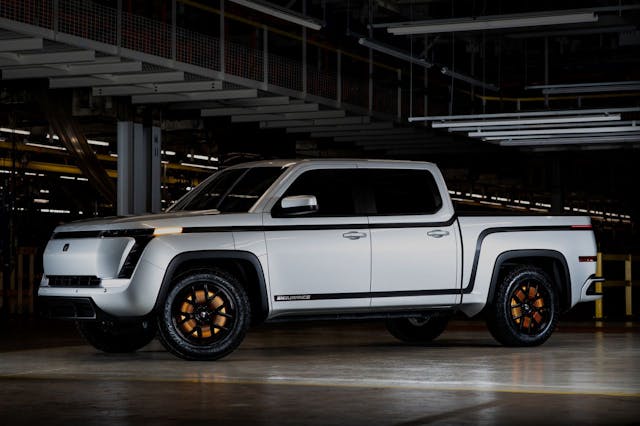
Intake: In a quarterly filed report with the SEC, Lordstown Motors revealed that the electric-truck upstart is currently low on the cash required to enter full scale production. This development, however, hasn’t yet altered their target to begin production on their Endurance model in September. CEO Steve Burns recently stated that the company is on track to make less than 1,000 units this year, which is less than half of the original 2,200 goal. It appears a long-term future is also in question. The filing reads, “Our current budget only provides for limited commencement of production in 2021. Additional funding is needed for production in 2022 and beyond and to continue our ramp up to full commercial production. The amounts required may be significant.”
Exhaust: Today, the company’s share price (ticker RIDE) fizzled to a weekly low of $8.89 per share, when a massive mid-afternoon green block gauzed the bleeding and stabilized the dive. RIDE closed the day at $11.23 per share. Fundamentally, the company is on its knees, begging for a lifeline. Maybe Reddit’s retail trading army will come to its rescue. In any case, it’ll need nothing short of a miracle to come back and compete in the waters where the F-150 Lightning lurks.
